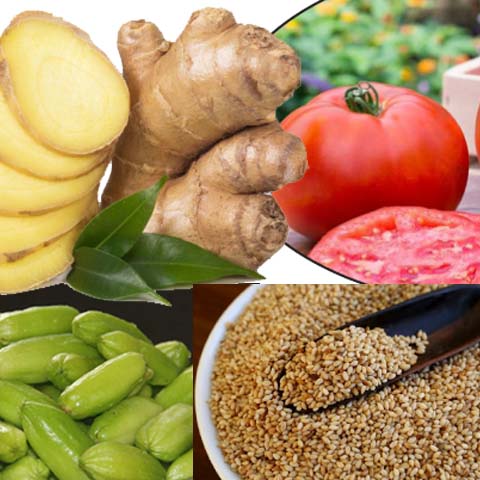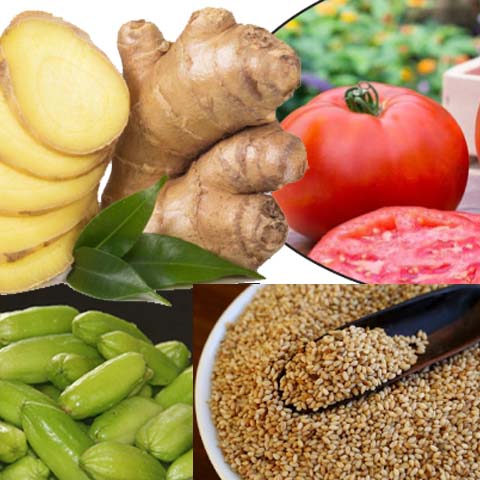
Spices and flavors have been popular for centuries because they provide excitement and liveliness to food, eating and dining. You can also add zest and pizzazz to your health and wellness by taking spices and flavors as medicine. Here are a few more spices and flavors that heal.
Kamatis or tomato (Lycopersicon lycopersicum L. or Lycopersicon esculentum Mill.). Tomato, botanically, is really a fruit, although most of us refer to it as a vegetable.
It is mainly used in the kitchen as a spice and for flavoring. The fruit contains organic acids (malic acid, citric acid, oxalic acid), iron, potassium, calcium, phosphorous, vitamins A, B, and C and trace elements of chlorine and sulphur.
The unripe fruit and leaves have tomatin, an antibiotic which is reasonably effective against some fungi causing skin diseases. Tomatin also has some antihistaminic activity.
The leaves are also a good source of iron and phosphorus. The seeds contain globulin, amino acids, vitamin A, B and C, solanine and tomatin.
Tomato, whether raw, cooked, dried or as a juice, sauce, paste or jam, has now become more popular due to its anti-oxidant content called lycopene.
Research findings show that lycopene has the ability to reduce the risk of myocardial infarction (heart attack) and prostate cancer as well as lung, stomach and gland cancers.
Lycopene is also found in mushroom, watermelon and grapefruit.
Medicinal uses of tomato: Slices of the fresh fruit are used as a poultice for skin infections and for mild skin burns. Because of its alkalinity, it is useful for any excess acid production in the body.
Eating a tomato in the morning or drinking a glassful of fresh tomato juice or just including tomato in your daily diet, is nutritiously excellent as well as very good in the prevention of diseases of the heart, prostate, liver and intestines.
Kamias (Averrhoa bilimbi L.). Kamias is mainly a Southeast Asian fruit and therefore has no English equivalent. Kamias is mainly cooked to make pickles and sambal. It is a main flavoring for sinigang (sour soup) and is added to fish curries. Together with chilies, it makes a good sour and spicy side dish. The fruit is rich in vitamin C.
The recommended medicinal use is as a cooling drink for fever. Mash two to three ripe fruits in a glass of water. Add sugar to taste. Traditionally, the decoction of the leaves is used as a bath after childbirth. An infusion of the flower is taken for cough.
Linga or Sesame (Sesamum orientale L., Sesame indicum). The seeds have been popularly used for millennia in Asia and Africa. Sesame has three kinds of seeds: white seeds which are rich in calcium and lecithin; the black seeds which are a rich source of iron; and the red seeds, also rich in iron. Sesame seeds also contain niacin, phosphorus, sulfur, proteins and carbohydrates. The seeds are often used as a coating to give a delicate nutty flavor to savory and sweet food, cookies, bread and casserole.
The seeds contain 50 to 60 percent fixed oil. This sesame oil has the finest flavor and can be used for frying, pickles, chutneys, and seasoning and as a paste mixed with cooked vegetable.
The recommended medicinal use of sesame is for constipation. Take roasted seeds, alone or mixed liberally, with other food. Nutritionally, the black and red seeds are good for anemia. Traditionally, it is used for hemorrhoids. The seeds are ground and mixed with water and applied for bleeding hemorrhoids. Half a teaspoon of powdered seeds taken with hot water twice daily has been used for painful menstruation. Sesame oil can be applied to skin ulcers, burns and scalds. The oil is also used as a massage treatment for rheumatism.
Luya or Ginger (Zingiber officinale Rosc). For culinary purposes, ginger is widely used in soups, pickles, bread, cookies, cakes and pudding. It is used as an ingredient in curry dishes. It is used to produce ginger beer, ginger ale and ginger wine.
The rhizome has several volatile oils and an oleoresin. It has also been found to be anti-tuberculosis in vitro and to have anti-histamine property. It also contains calcium, phosphorus, iron, vitamin C and small amounts of vitamin B complex.
The recommended medicinal uses are:
• As antiseptic: prepare tincture of the dried rhizome with 70 percent alcohol (ethyl alcohol but not rubbing; gin or lambanog, distilled coconut wine) and apply on superficial cuts. The juice of the fresh rhizome can also be used.
• For gas pain and indigestion: Take decoction of the rhizome (salabat) as tea. Honey or sugar may be added, as desired.
• For sore throat, pharyngitis and cough: Take warm decoction of the rhizome as tea or chew a small piece of the rhizome.
• For rheumatism and arthritis: Pound, roast, mix with coconut or baby oil and apply on painful areas. The ginger can also be mixed with equal amounts of cayenne or siling labuyo (Capsicum frustescens L.) and garlic (Allium sativum L.). Boil the three spices in an equal amount of coconut or baby oil for three minutes. Cool and apply on affected areas.
